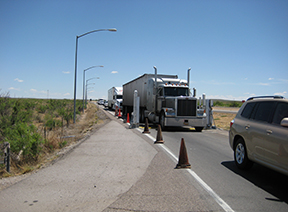
US border and immigration policy remains a central topic of discussion for politicians, the media, and citizens. But even as cable news commentators continue to debate the issue and the presumed Democratic and Republican presidential candidates formulate their own immigration policies, Sandia researchers have been working with the Domestic Nuclear Detection Office (DNDO) and Customs and Border Protection (CBP), specifically the Border Patrol, to study the border for another reason: the nuclear terrorist threat.
For the past three years, Sandia researchers have been studying the problem of how to prevent nuclear smuggling through “non-port-of-entry” border regions, which are loosely defined as the broad swath of land patrolled by Border Patrol where it is illegal to enter the country. Non-POE can include fixed interior checkpoints, regions that are patrolled by agents on horseback or on all-terrain vehicles, and other locations along the US border, which extends nearly 2,500 miles in the southern US and more than 3,000 miles in the north.
The border may itself be a distinct line with clear separation between nations. The Border Patrol, however, is responsible for a region that can extend up to 100 miles wide, and they conduct operations throughout this region. Consequently, the studies Sandia has been conducting have necessarily focused on the diverse operations employed by Border Patrol agents in various parts of the country.
Operational flexibility
“The main tenet for Border Patrol agents, we’ve learned, is operational flexibility,” says Jason Reinhardt (8130), a Sandia electrical engineer who’s been involved in Sandia’s border security and radiation detection work since 2002.
“At a port, you can install large, stationary pieces of equipment and enjoy a higher level of confidence that they’ll perform consistently. Also, you can dedicate personnel whose main focus is operating the portals. For Border Patrol use, the equipment needs to be portable and fit within the scope of the agent’s other equipment and tasks.”
Such operational realities, Jason says, often go against the fundamental physics of radiation detection, adding to the overall challenge of deploying a viable detection system that meets the needs of the end users.
The performance of sophisticated detection equipment, while a current subject of debate among lawmakers, is clearly unsuited to non-POE applications for demonstrable, operational reasons, according to Jason. Such equipment, he explains, is difficult to use in the often-harsh and unpredictable environments that border agents can encounter. Heavy winds, dust, downpours, and other environmental realities all contribute to the problem, and the Border Patrol agents themselves are often patrolling wide-open spaces on foot or in a small vehicle, which makes the packaging and portability of detection equipment next to impossible.
A systematic, step-by-step approach
In addition to trying to understand the operations of the Border Patrol agents, Sandia has at the same time been analyzing specific, off-the-shelf radiation detection equipment that could be made part of the border’s defense posture. This is especially key, Jason says, since the effectiveness of many of the radiation detection products is often “oversold” by manufacturers or may not take into account the operational realities involved.
Taking a phased approach to the work, the researchers typically study the instruments in a controlled laboratory environment first before taking the equipment to the Nevada Test Site or the Albuquerque-based Technical Evaluation Assessment Monitor Site (TEAMS) for further evaluation. Then, they familiarize border agents with the instruments back in the lab and, finally, move out to the field with the agents and begin to integrate the equipment with CBP’s regular operations.
Jason and his Sandia colleagues have spent considerable time examining border regions in the southern and southwestern US and will likely continue to focus in that part of the country for the foreseeable future, with more of an emphasis on systems engineering than testing and evaluation.
Next up: a look at unattended sensors
The research team’s next step, Jason says, is to analyze the voluminous data collected during a recent deployment of equipment at a Southwest border location. Afterward, they’ll deliver a technical report to DNDO that outlines the findings and recommended requirements that Sandia believes may make radiation detection a viable activity in both the short and long term. It’s also possible, Jason says, that a longer test series will occur at a yet-to-be-determined border location sometime next year.
If radiation detection systems turn out to be the direction DNDO and CBP choose to go, unattended sensors could be a part of a future radiation detection system along the border, Jason says. It’s easier said than done, of course, and DNDO will likely need to engage industry partners to develop and engineer new hardware that meets both the performance requirements and operational demands of CBP and its agents.
Until then, Jason says, he and his colleagues will continue to plug away, learning the needs of CBP’s agents along the border, analyzing the radiation detection solutions available today, integrating them into CBP operations, and making technical and operational recommendations for the future.